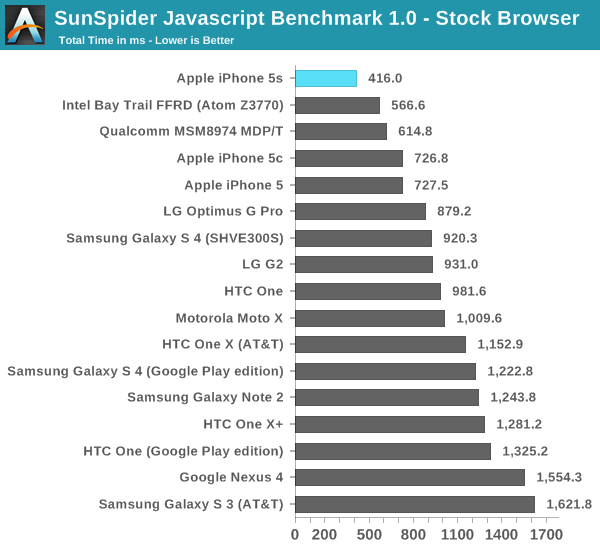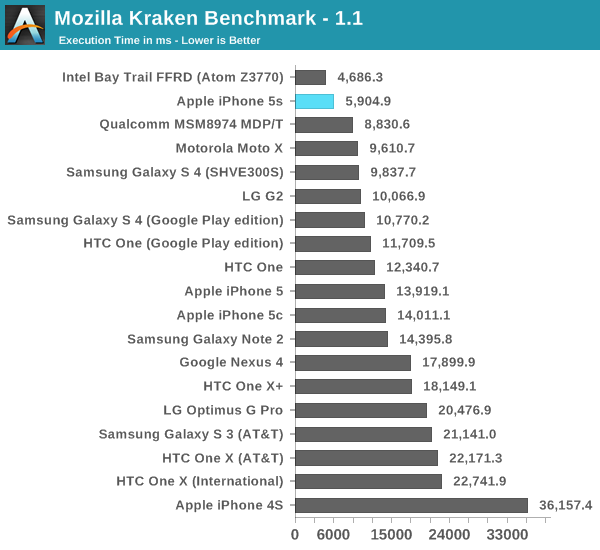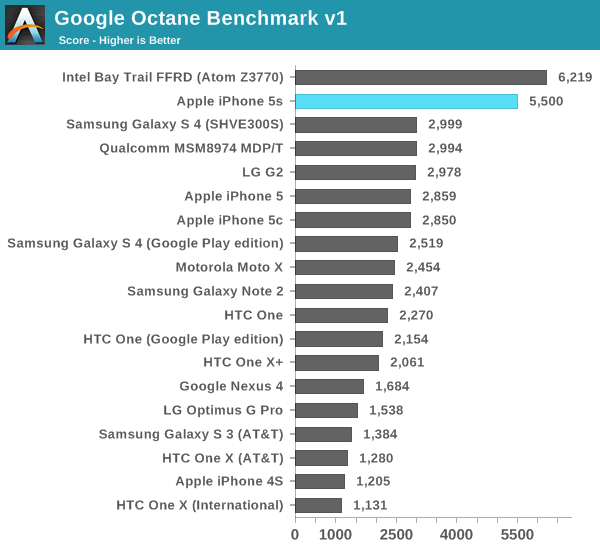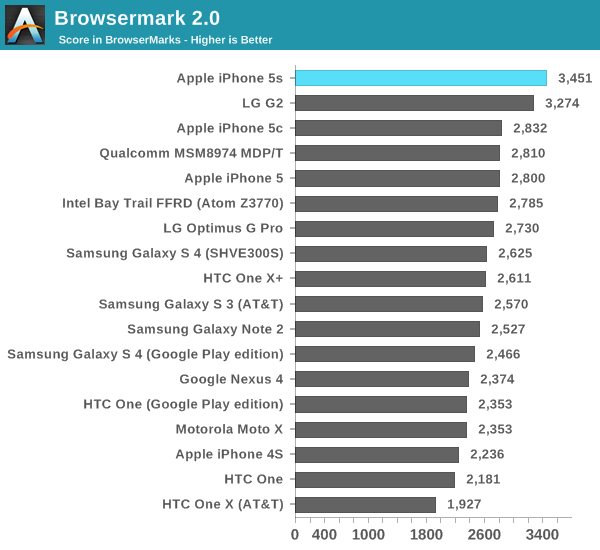The iPhone 5s Review
by Anand Lal Shimpi on September 17, 2013 9:01 PM EST- Posted in
- Smartphones
- Apple
- Mobile
- iPhone
- iPhone 5S
CPU Performance
For our cross-platform CPU performance tests we turn to the usual collection of Javascript and HTML5 based browser tests. Most of our comparison targets here are smartphones with two exceptions: Intel's Bay Trail FFRD and Qualcomm's MSM8974 Snapdragon 800 MDP/T. Both of those platforms are test tablets, leveraging higher TDP silicon in a tablet form factor. The gap between the TDP of Apple's A7 and those two SoCs isn't huge, but there is a gap. I only include those platforms as a reference point. As you're about to see, the work that Apple has put into the A7 makes the iPhone 5s performance competitive with both. In many cases the A7 delivers better performance than one or both of them. A truly competitive A7 here also gives an early indication of the baseline to expect from the next-generation iPad.
We start with SunSpider's latest iteration, measuring the performance of the browser's js engine as well as the underlying hardware. It's possible to get good performance gains by exploiting advantages in both hardware and software here. As of late SunSpider has turned into a bit of a serious optimization target for all browser and hardware vendors, but it can be a good measure of an improving memory subsystem assuming the software doesn't get in the way of the hardware.

Bay Trail's performance crown lasted all of a week, and even less than that if you count when we actually ran this benchmark. The dual-core A7 is now the fastest SoC we've tested under SunSpider, even outpacing Qualcomm's Snapdragon 800 and ARM's Cortex A15. Apple doesn't quite hit the 2x increase in CPU performance here, but it's very close at a 75% perf increase compared to the iPhone 5. Update: Intel responded with a Bay Trail run under IE11, which comes in at 329.6 ms.
Next up is Kraken, a heavier js benchmark designed to stress more forward looking algorithms. Once again we run the risk of the benchmark becoming an optimization target, but in the case of Kraken I haven't seen too much attention paid to it. I hope it continues to fly under the radar as I've liked it as a benchmark thus far.

The A7 falls second only to Intel's Atom Z3770. Although I haven't yet published these results, the 5s performs very similarly to an Atom Z3740 - a more modestly clocked Bay Trail SKU from Intel. Given the relatively low CPU frequency I'm not at all surprised that the A7 can't compete with the fastest Bay Trail but instead is better matched for a middle of the road SKU. Either way, A7's performance here is downright amazing. Once again there's a performance advantage over Snapdragon 800 and Cortex A15, both running at much higher peak frequencies (and likely higher power levels too, although that's speculation until we can tear down an S800 platform and a 5s to compare).
Compared to the iPhone 5, the 5s shows up at over 2.3x the speed of last year's flagship.
Next up is Google's Octane benchmark, yet another js test but this time really used as a design target for Google's own V8 js engine. Devices that can run Chrome tend to do the best here, potentially putting the 5s at a disadvantage.

Bay Trail takes the lead here once again, but again I expect the Z3740 to be a closer match for the A7 in the 5s at least (it remains to be seen how high the iPad 5 version of Cyclone will be clocked). The performance advantage over the iPhone 5 is a staggering 92%, and obviously there are big gains over all of the competing ARM based CPU architectures. Apple is benefitting slightly from Mobile Safari being a 64-bit binary, however I don't know if it's actually getting any benefit other than access to increased register space.
Our final browser test is arguably the most interesting. Rather than focusing on js code snippets, Browsermark 2.0 attempts to be a more holistic browser benchmark. The result is much less peaky performance and a better view at the sort of moderate gains you'd see in actual usage.

There's a fair amount of clustering around 2500 with very little differentiation between a lot of the devices. The unique standouts are the Snapdragon 800 based G2 from LG, and of course the iPhone 5s. Here we see the most modest example of the A7's performance superiority at roughly 25% better than the iPhone 5. Not to understate the performance of the iPhone 5s, but depending on workload you'll see a wide range of performance improvements.










464 Comments
View All Comments
Wilco1 - Thursday, September 19, 2013 - link
The Geekbench results are indeed skewed by AES encryption. The author claimed AES was the only benchmark where they use hardware acceleration when available. There has been a debate on fixing the weighting or to place hardware accelerated benchmarks in a separate category to avoid skewing the results. So I'm hoping a future version will fix this.As for cross-platform benchmarking, Geekbench currently uses the default platform compiler (LLVM on iOS, GCC on Android, VC++ on Windows). So there will be compiler differences that skew results slightly. However this is also what you'd get if you built the same application for iOS and Android.
smartypnt4 - Thursday, September 19, 2013 - link
A lot of the other stuff in Geekbench seems to be fairly representative, though. Except a few of the FP ones like the blur and sharpen tests...It surely can't be hard to have Geekbench omit those results. I think if they did that, you'd see that the A7 is roughly 50-60% faster than the A6 instead of 100% faster, but I'm not sure there. I'd have to go and do work to figure that out. Which is annoying :-)
name99 - Wednesday, September 18, 2013 - link
I'd agree with the tweaks you suggest: (improved memory controller and prefetcher, doubling of L2, larger branch predictor tables).There is also scope for a wider CPU. Obviously the most simple-minded widening of a CPU substantially increases power, but there are ways to limit the extra power without compromising performance too much, if you are willing to spend the transistors. I think Apple is not just willing to spend the transistors, but will have them available to spend once they ditch 32-bit compatibility. At that point they can add a fourth decoder, use POWER style blocking of instructions to reduce retirement costs, and add whatever extra pipes make sense.
The most useful improvement (in my experience) would be to up the L1 from being able to handle one load+store cycle to two loads+ one store per cycle, but I don't know what the power cost of that is --- may be too high.
On the topic of minor tweaks, do we know what the page size used by iOS is? If they go from 4K to 16K and/or add support for large pages, they could get a 10% of so speed boost just from better TLB coverage.
(And what's Android's story on this front? Do they stick with standard 4K pages, or do they utilize 16 or 64K pages and/or large pages?)
extide - Wednesday, September 18, 2013 - link
Those are some pretty generous numbers you pulled out of your hat there. It's not as easy as just do this and that and bam, you have something to compete with Intel Core series stuff. No. I mean yeah, Apple has done a great job here and I wish someone else was making CPU's like this for the Android phones but oh well.name99 - Wednesday, September 18, 2013 - link
"Now, I will agree that this does prove that if Apple really wanted to, they could build something to compete with Haswell in terms of raw throughput."I agree with your point, but I think we should consider what an astonishing statement this is.
Two years ago Apple wasn't selling it's own CPU. They burst onto the scene and with their SECOND device they're at an IPC and a performance/watt that equals Intel! Equals THE competitor in this space, the guys who are using the best process on earth.
If you don't consider that astonishing, you don't understand what has happened here.
(And once again I'd make my pitch that THIS shows what Intel's fatal flaw is. The problem with x86 is not that it adds area to a design, or that it slows it down --- though it does both. The problem is that it makes design so damn complex that you're constantly lagging; and you're terrified of making large changes because you might screw up.
Apple, saddled with only the much smaller ARM overhead, has been vastly more nimble than Intel.
And it's only going to get worse if, as I expect, Apple ditches 32-bit ARM as soon as they can, in two years or so, giving them an even easier design target...)
What's next for Apple?
At the circuit level, I expect them to work hard to make their CPU as good at turboing as Intel. (Anand talked about this.)
At the ISA level, I expect their next major target to be some form of hardware transactional memory --- it just makes life so much easier, and, even though they're at two cores today, they know as well as anyone that the future is more cores. You don't have to do TM the way Intel has done it; the solution IBM used for POWER8 is probably a better fit for ARM. And of course if Apple do this (using their own extensions, because as far as I know ARM doesn't yet even have a TM spec) it's just one more way in which they differentiate their world from the commodity ARM world.
smartypnt4 - Wednesday, September 18, 2013 - link
@extide: agreed.@name99: It is very astonishing indeed. Then again, a high profile company like Apple has no problem attracting some of the best talent via compensation and prestige.
They've still got quite a long way to match Haswell, in any case. But the throughput is technically there to rival Intel if they wanted to. I would hope that Haswell contains a much more advanced branch predictor and prefetcher than what Apple has, but you never know. My computer architecture professor always said that everything in computer architecture has already been discovered. The question now is when will it be advantageous to spend the transistors to implement the most complicated designs.
The next year is going to be very interesting, indeed.
Bob Todd - Wednesday, September 18, 2013 - link
How many crows did you stuff down after claiming BT would be slower than A15 and even A12? Remember posting this about integer performance?"Silverthorne < A7 < A9 < A9R4 < Silvermont < A12 < Bobcat < A15 < Jaguar"
Apple's A7 looks great, but you've made so many utterly ridiculous Intel performance bashing posts that it's pretty much impossible to take anything you say seriously.
Wilco1 - Wednesday, September 18, 2013 - link
BT has indeed far lower IPC than A15 just like I posted - pretty much all benchmark results confirm that. On Geekbench 3 A15 is 23-25% faster clock for clock on integer and FP.The jury is still out on A12 vs BT as we've seen no performance results for A12 so far. So claiming I was wrong is not only premature but also incorrect as the fact is that Bay Trail is slower.
Wilco1 - Wednesday, September 18, 2013 - link
Also new version with A7 and A57 now looks like this:Silverthorne < A7 < A9 < A9R4 < Silvermont < A12 < Bobcat < A15 < Jaguar < A57 < Apple A7
Bob Todd - Wednesday, September 18, 2013 - link
Cherry picking a single benchmark which is notoriously inaccurate at comparisons across platforms/architectures doesn't make you "right", it just makes you look like more of a troll. Bay Trail has better integer performance than Jaguar (at near identical base clocks), so by your own ranking above it *has* to be faster than A12 and A15.You show up in every ARM article spouting the same drivel over and over again, yet you were mysteriously absent in the Bay Trail performance preview. Here's the link if you want to try to find a way to spin more FUD.
http://anandtech.com/show/7314/intel-baytrail-prev...
Apple's A7 looks great, and IT is still the powerhouse of mobile graphics. The A7 version in the iPad should be a beast. None of that makes most of your comments any less loony.